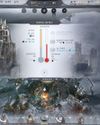
There’s some benchmarking software you may have heard of called 3DMark. It’s on Steam. Recently, it updated its benchmarks to include the 3DMark Mesh Shader Feature Test, which requires a GPU that’s compatible with DirectX 12 Ultimate. The test runs twice, once with mesh shaders disabled, then again with them switched on. In 4K, using an RTX 3080 card, we got a framerate of around 50 fps for the first run, then something closer to 500 fps for the second, with no perceivable difference in what was displayed on the screen. How the heck did that happen?
‘Shaders’ is a term that’s been thrown around in videogames for a while now, and while it seems straightforward it’s not exactly obvious. Shaders are programs that run on programmable GPUs (that’s most of them) that control the levels of light, dark, and color in rendered images. They’re a major part of modern games’ lighting effects, and there are whole shader languages for graphics programmers to, well, program graphics in.
Pixel shaders were the ray tracing of their time—players of The Elder Scrolls III: Morrowind in 2002 may remember being asked whether they wanted to activate pixel shaders. They only worked if you had a high-end graphics card, there was a bit of a performance hit, but they made the water look awesome. Just like ray tracing, then. Modern pixel shaders do a lot, from bump mapping to shadows to the motion blur you turn off in every game.
この記事は PC Gamer US Edition の July 2021 版に掲載されています。
7 日間の Magzter GOLD 無料トライアルを開始して、何千もの厳選されたプレミアム ストーリー、9,000 以上の雑誌や新聞にアクセスしてください。
すでに購読者です ? サインイン
この記事は PC Gamer US Edition の July 2021 版に掲載されています。
7 日間の Magzter GOLD 無料トライアルを開始して、何千もの厳選されたプレミアム ストーリー、9,000 以上の雑誌や新聞にアクセスしてください。
すでに購読者です? サインイン

"The War Within itself has kept me coming back most evenings too"
WORLD OF WARCRAFT remains my jailer, and I couldn't be more pleased about it

OK BUILDER
SATISFACTORY is the new titan in building and crafting games

HELL YES
DIABLO IV: VESSEL OF HATRED is a transformative expansion

MOUSE: PI FOR HIRE
This mouse wants to be more than just a gimmick

WINDBLOWN
Dead Cells dev's new roguelike has me afraid for my free time

NO MORE ROOM IN HELL 2
As the zombie horde surrounded me just moments after taking down my two remaining teammates, the writing was really on the wall. Armed with just a chef's knife, it was clear I stood no chance, but I was going down swinging, hoping for a miracle... it didn't come.

OWNED BY STEAM
VALVE cordially reminds you that your games aren't yours

CURSE OF THE AZURE BONDS
These classic games haven't aged badly, but I sure have.

DEEP FREEZE
Endure a blizzard of tough choices and rough consequences in FROSTPUNK 2

NEW HORIZONS
Building up REMNANT 2 outside the live service game grinder